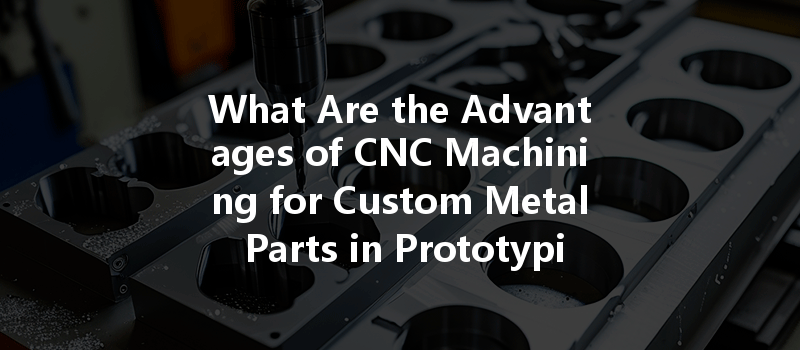Did you know that more than 80% of prototypes in the manufacturing industry today are created using digital technologies? In our rapidly evolving manufacturing landscape, Computer Numerical Control (CNC) machining stands out as a pivotal technology driving this transformation. This blog will delve into the numerous advantages of CNC machining, particularly its role in producing custom metal parts for prototypes. We’ll explore its efficiencies, accuracy, versatility, and cost-effectiveness in prototyping, giving you a comprehensive understanding of why this technology is essential for modern manufacturing.
Understanding CNC Machining
What is CNC Machining?
CNC machining is a subtractive manufacturing process that involves the use of computers to control machine tools. This technology allows for high precision and repeatability, making it a cornerstone for creating complex components from a variety of materials, including metals, wood, plastics, and composites.
Key Components of CNC Machining:
Why Choose CNC Machining for Custom Prototyping?
The use of CNC machining in prototyping offers several advantages over traditional manual machining and other manufacturing techniques. Let’s take a detailed look at these benefits.
CNC machines operate with extreme precision, often achieving tolerances within ±0.001 inches. This accuracy is crucial for creating complex designs where the smallest error can lead to significant issues during the assembly of parts. CNC technology ensures that each part produced remains consistent across numerous iterations, enhancing the overall quality and reliability of prototypes.
CNC machining drastically reduces the time required for production. Traditional prototyping processes often involve lengthy manual setups and adjustments, but CNC machines can be programmed to run automated cycles. This not only speeds up the manufacturing process but also allows for the rapid production of multiples of the same part, which is beneficial when testing different designs.
CNC machining supports a wide range of materials, allowing engineers and designers to choose the most suitable options for their prototypes. From metals like aluminum, titanium, and stainless steel to plastics and composites, CNC technology can process them all. This flexibility enables custom prototypes to be developed with the exact material characteristics that a designer requires.
While the initial investment in CNC machinery can be significant, the long-term savings often outweigh these costs. CNC machining minimizes waste through precise cuts and repeated setups. In prototyping, where multiple iterations may be needed, this efficiency translates into cost savings. Moreover, faster production times lead to quicker time-to-market, which can be a crucial advantage.
The manipulation of CNC machinery allows manufacturers to produce intricate designs that would be difficult, if not impossible, to achieve with manual methods. This capability opens doors to innovative design concepts, resulting in products that not only meet but exceed the expectations of their end-users.
The Prototyping Process and CNC Machining Workflow
Understanding the flow of the CNC machining process in prototyping can help businesses streamline their workflows. Below, we outline the key steps in the prototyping process using CNC machining:
Step 1: Design
The journey begins with a detailed design, typically formulated in CAD software. Designers must consider not only aesthetics but also functionality, material properties, and machining constraints.
Step 2: CAM Programming

Once the design is finalized, it is imported into Computer-Aided Manufacturing (CAM) software. Here, the program generates detailed instructions for the CNC machine, including tool paths, speeds, and feeds.
Step 3: Machine Setup
CNC operators set up the machine by loading the raw material and ensuring that all toolheads and fixtures are correctly aligned. This step includes calibration checks to maintain precision.
Step 4: Machining
With everything set up, the CNC machine is put to work. The automation allows for the manufacturing of parts with minimal oversight, often producing several iterations in a single run.
Step 5: Quality Control & Testing
After machining, parts undergo quality control processes, including checks for dimensional accuracy and material properties. Prototypes are often subjected to various tests to ensure they perform as intended before final approval.
Step 6: Post-Processing
Depending on the application, post-processing steps such as surface finishing, heat treatment, or assembly might be necessary. These steps refine the final product and enhance its functionality.
Common Applications of CNC Machining in Prototyping
Challenges of CNC Machining in Prototyping
Despite its advantages, CNC machining does have its drawbacks. Understanding these challenges is essential for manufacturers looking to optimize their processes.
The cost of CNC machines and their maintenance can be considerable. Small businesses or startups might find this initial cost a barrier to entry.
Operating CNC machines requires skilled technicians who can program and maintain the equipment. Investing in training can mitigate this challenge, but it demonstrates a commitment of resources.
CNC machining may struggle with significantly thick materials, often leading to issues with tool wear and processing speeds. Understanding the limitations of different materials is crucial for effective prototyping.
CNC machining has fundamentally transformed the prototyping landscape, providing unparalleled precision, speed, and versatility for custom metal parts. By adopting CNC technology, manufacturers can reduce production times, enhance product quality, and ultimately foster innovation. However, successful implementation requires careful planning, investment in skilled personnel, and an understanding of the challenges involved.
As the manufacturing industry continues to evolve, CNC machining will undeniably play a vital role in pushing boundaries and exploring new possibilities in prototyping. By leveraging this technology, businesses can facilitate a faster time-to-market and deliver high-quality products to meet the ever-evolving demands of consumers.
In summary, investing in CNC machining services for custom metal parts not only makes your prototype creation process robust and efficient but also positions your business at the forefront of industry innovation. It’s a topic worth considering as you plan your next steps in product development.






